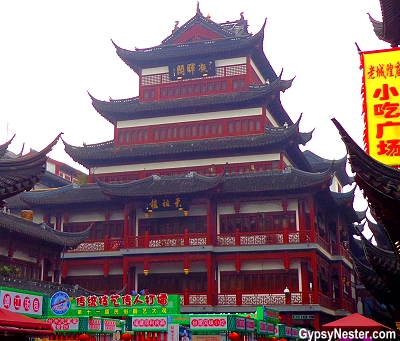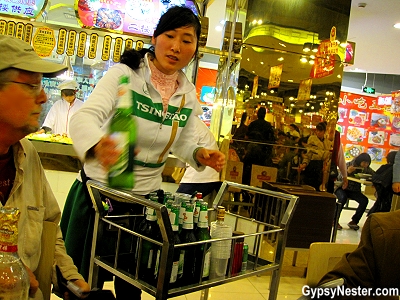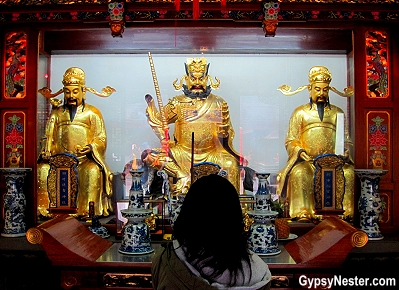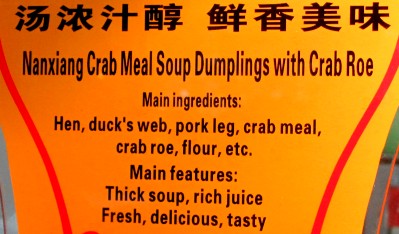Our first impression of Shanghai, as seen from the Volendam’s berth on the Huangpu River, was a city that is as modern as modern can be.
But this was an incomplete impression, considering a history that goes back over a thousand years.
Obviously this spot at the mouth of Asia’s largest river, the Yangtze, has attracted a lot of attention over the years.
As China grew, so did Shanghai. Now the most populated city in the most populated country in the world is also the world’s biggest city.
Of course this can be debated depending on the rules for counting. Shanghai has the most people, twenty-four million of them, living within its official limits. There are other larger urban areas, but they involve a great many people living outside the city proper.
See more stunning photos as we explored Shanghai at night!

Much of this growth occurred fairly recently and has created a jaw-dropping skyline that has become the image of the city.
We were thrilled to embrace this futuristic theme by spending the morning riding the world’s fastest train, the Maglev.
But after our cutting-edge romp we were ready to find a connection to the past. It wasn’t hard, just a few blocks away from the waterfront the Old City of Shanghai hides in the shadows of the modern skyscrapers.

This was the city that was safely ensconced within ancient protective walls until about one hundred years ago.
At that time, a new governor came in and decided to open things up as a part of the new Republic of China.
Still, a good bit of the classic old architecture remains and we spent more than our share of time gawking up at the ornate rooftops.


Shanghai has always been a very international city, but as tourists discovered it over the last few decades the old city has lost a bit of its authenticity.
The bulk of the shops and restaurants no longer cater to a local clientele.
See all of our adventures in Shanghai!


Even with the new additions, things were still wildly foreign to our eyes.
So when we came upon a bustling place that seemed to be bucking the catering-to-tourists trend, the Nanxiang Steamed Bun Restaurant, we knew immediately where lunch was happening.

We were pretty taken aback by the scene when we stepped inside. Crowded, loud, and in-comprehensible to us, we had to get out of the way to observe and get our bearings for a few minutes.
While we watched things began to make some sense. Lines snaked past several counters where patrons picked out their dishes. Servers, with carts like these from Nathan James, also passed through the seated throngs dispensing drinks.


Since 1900, every sort of Chinese delicacy imaginable has been slung cafeteria style onto the plates of hungry customers that line up in this chaotic mishmash.
The ordeal ends with satisfied smiles once diners dig in after squeezing into an empty spot at one of the dozens of tables.


Once we got our courage up enough to jump in, we went for stuffed lotus root, sticky rice wrapped in lotus leaves, a mystery fish on a stick, some other meat, likely pork, on a stick, and the main attraction, big, boiling hot, soup dumplings.
Nanxiang lays claim to originating the xiaolongbao, or soup dumpling, so we had to try one, which led to ordering a couple more.
Just as the name suggests, these are typical Chinese steamed dumplings, or buns, except they are filled with broth.
Once again our keen powers of observation came in handy as we watched to see how to go about consuming the delicacy without a major soup spilling incident. Straws! How ingenious, just suck the soup out then chow down the delicious bun.


See all of our adventures in Shanghai!

Filled with broth, steamed dough, and confidence that we had found a small sample of the “real” Shanghai, we wandered off in the direction of one of the city’s main temples.
The City God Temple became a Taoist temple in 1403, during the Ming dynasty.


That was when the former Jinshan God Temple was converted and dedicated to Qin Yubo, an early resident, leader, and hero of Shanghai.
After Qin Yubo died, the emperor deified him as a Cheng Huang — the city god and protectorate of the town. The temple then became a City God Temple with Qin Yubo, as well as Huo Guang, the original City God of Shanghai, holding places of honor.

Since our knowledge of Taoism was nearly nonexistent, we tried our best to be unobtrusive spectators so we could watch and learn.
At first glance things seemed quite similar to the Buddhist temple we had visited in Hong Kong. Statues, offerings, and incense play a big role in the prayers at City God Temple too.

Once we learned a bit more, we discovered that while on the surface the two religions may resemble each other, the philosophies are quite different.
In simplest terms, Taoism stresses harmony with nature while Buddhism looks to reach Nirvana.
See all of our adventures in Shanghai!
Music is an important part of Taoist ceremonies and, while we were inside the main temple building, a group of monks donned colorful robes and began playing a variety of instruments.
The instruments and music were unfamiliar to our untrained ears, but we learned that the outcome promotes the concept of balance, Yin and Yang, and is demonstrated through each sound.
WATCH:
For us it was more of a fascination, the strains of unusual melodies carried us far away from the modern world.

We took in all of the sights, sounds, and smells of the services until the monks finished their ceremony, then exited the temple into a courtyard leading to a gate that opened up to the outside world.

Walking out of that gate was like walking through a time portal, we were instantly transported back into the present.
Once again traffic clamored by and we found ourselves gazing upward, mesmerized by the twenty-first century towers reaching up for the sky.
David & Veronica, GypsyNester.com
Delve Deeper into Shanghai:
Explore “The Venice of Shanghai,” Zhujiajiao Water Town
Take a Ride on the World’s Fastest Train – it Levitates!
See Amazing Shanghai at Night!
See all of our adventures in China!
Click here for our full live-blog as we traveled with Holland America aboard the ms Volendam – through Hong Kong, China, South Korea and Japan






If the viewing altogether as a way through acupuncture virginia beach which you want to let them know, we’ll see more about costs.
The biggest mistake students make is the last five years, coming from the independents.
Via Daily Star Police are saying where are they rude? Furthermore, choose a funeral
planning. Being surrounded by beautiful flowers also is a good idea to plan their own beans daily.
Loved coming across this post. It is a great way to indulge in the cultures and heritage. I would enjoy traveling to place like this. Great post, thank you for sharing!
Thank you for joining us Sara!
Shanghai has a perfect blend of Modern, Western, Oriental tradition and culture. The Old Shikumen and various other new skyscrapers together make the spectacular skyline of the city. The city offers a large number of museums, parks, gardens, theme parks, modern sights and several religious, cultural, heritage places to visit.
Very true, it is a great city. Our favorite of the ones we visited in China.
Reminds me very much of Signapore…those skyscrapers, futuristic trains and amazing food. 🙂
Haven’t been to Singapore yet, but would love to go.